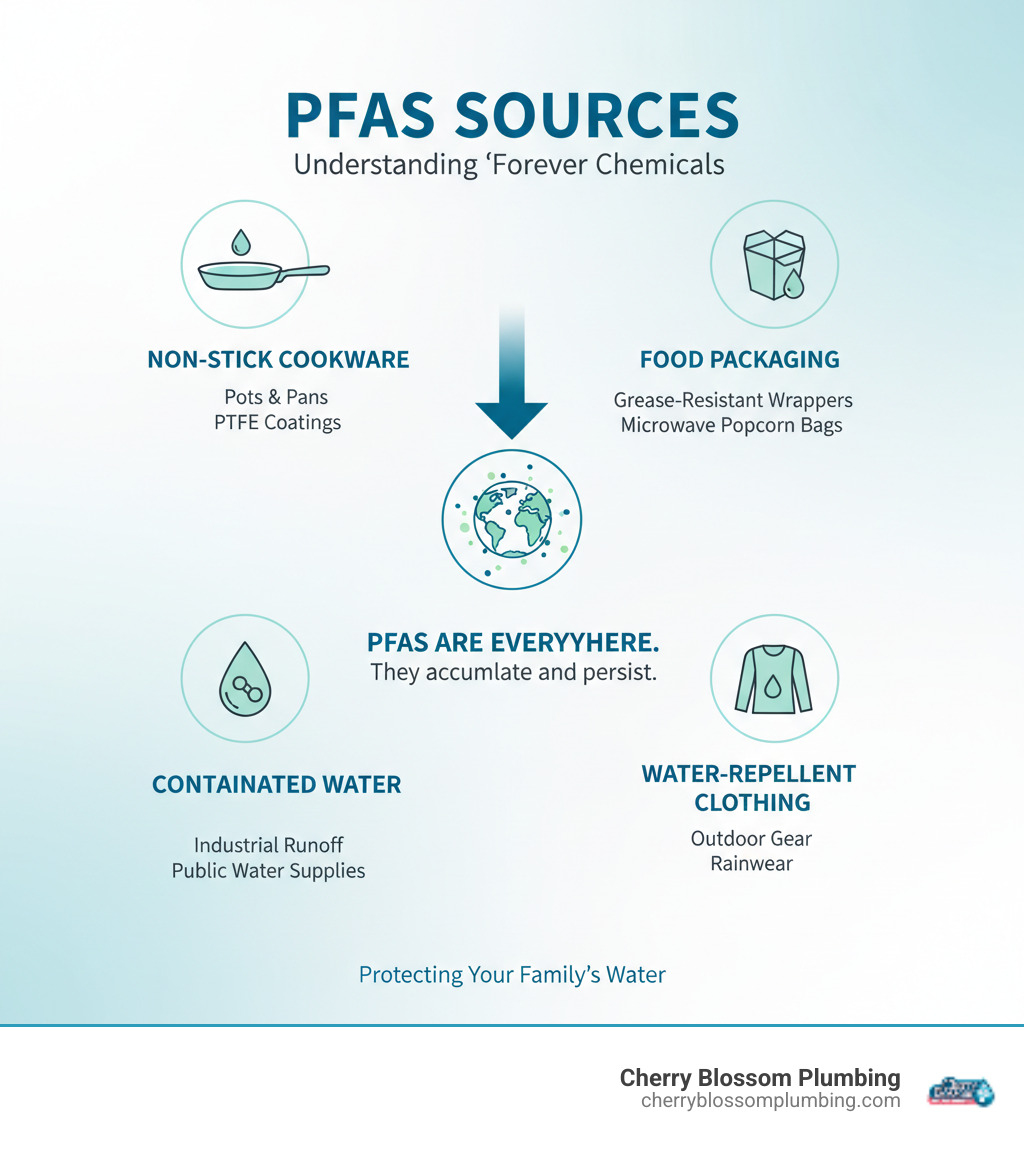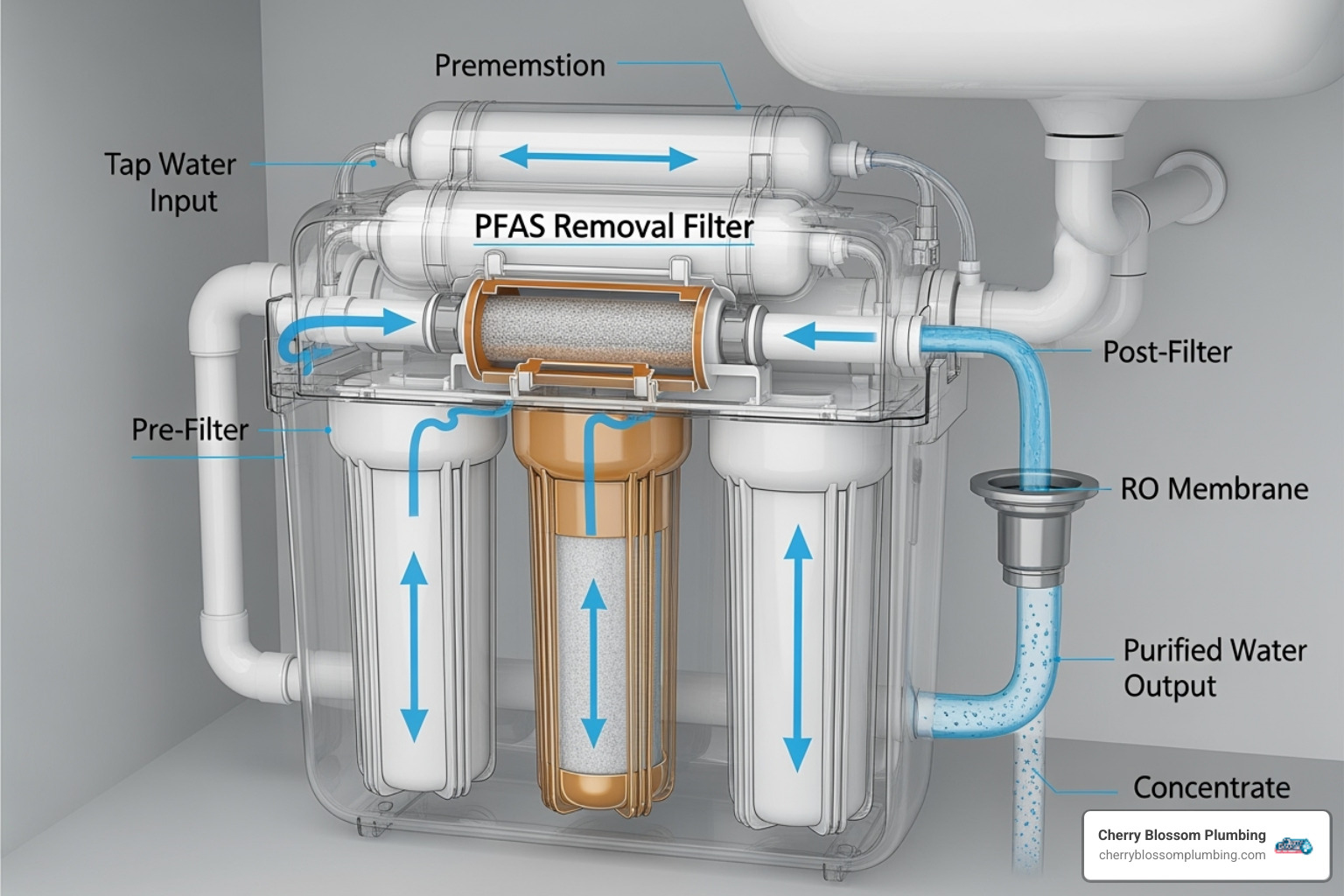
Why Understanding PFAS Reverse Osmosis Filters Matters
A pfas reverse osmosis filter is a specialized water treatment system that removes harmful "forever chemicals" from your drinking water. Almost half of the nation's tap water contains PFAS, and reverse osmosis systems equipped with proper filtration stages can remove up to 99% of these contaminants when certified to NSF/ANSI 53 or NSF/ANSI 58 standards.
Here's what you need to know about PFAS reverse osmosis filters:
- What it removes: PFAS (per- and polyfluoroalkyl substances), also called "forever chemicals"
- How effective: Up to 99% removal rate for most PFAS compounds
- Key requirement: Must have multi-stage filtration with activated carbon and RO membrane
- Look for: NSF/ANSI 53 or NSF/ANSI 58 certification for PFAS reduction
- Why it matters: PFAS are linked to cancer, immune system problems, and developmental issues
You might say PFAS just won't go away. These synthetic compounds contain strong carbon-fluorine bonds that make them incredibly resistant to breaking down in the environment. They're used in everything from non-stick cookware to waterproof clothing to food packaging. The problem is that they've contaminated water supplies across the country, and traditional water treatment methods can't remove them effectively.
PFAS are everywhere. They've been detected in the blood of 99% of Americans. They accumulate in your body over time because they don't break down. Exposure has been linked to serious health problems including cancer, thyroid disease, liver damage, and weakened immune systems.
The good news is that you can protect your family. A properly designed pfas reverse osmosis filter can dramatically reduce these chemicals in your drinking water. But not all systems are created equal. Standard RO systems may not be enough. You need specific filtration components designed to target PFAS.
I'm Amanda Casteel, and one myth I'm passionate about debunking is that county water is truly filtered—in reality, it's treated with chemicals like chlorine, and Arlington water actually contains more chlorine than a swimming pool. Through my work helping Northern Virginia families understand and improve their water quality, I've seen how the right pfas reverse osmosis filter can make a real difference in protecting your health.

Understanding PFAS: The 'Forever Chemical' Problem
You've probably heard the term "forever chemicals" in the news lately. It sounds ominous, doesn't it? Unfortunately, the reality lives up to the name. To understand why a pfas reverse osmosis filter is so important, we need to talk about what PFAS actually are and why they're such a stubborn problem.
PFAS stands for per- and polyfluoroalkyl substances. That's quite a mouthful, which is why everyone just calls them PFAS. These are human-made chemicals that have been around since the 1940s. What makes them special—and dangerous—are those incredibly strong carbon-fluorine bonds. These bonds are some of the strongest in chemistry, which means PFAS just don't break down. They stick around in the environment for decades, maybe centuries. That's where the "forever" part comes in.
Manufacturers loved PFAS because they repel water, oil, and heat. Need a pan that nothing sticks to? PFAS. Want a jacket that keeps you dry in a rainstorm? PFAS. Food packaging that resists grease? PFAS again. From personal care products to firefighting foam, these chemicals showed up everywhere.
Here's the problem: what makes PFAS so useful in products makes them terrible for our health and environment. They're now detected in air, soil, water, and even in the blood of 99% of Americans, including newborn babies. Think about that for a moment. These chemicals have become so widespread that virtually all of us carry them in our bodies.
The real concern isn't just that PFAS are everywhere—it's that they accumulate. Your body can't break them down or flush them out effectively. They build up over time, which is why even tiny amounts can cause health problems. The CDC and other health agencies have documented serious risks from this bioaccumulation.
Thankfully, regulators are finally taking action. The EPA recently finalized the first-ever national drinking water standard specifically for PFAS. This is a huge step forward in protecting families from these contaminants. But while we wait for municipal systems to fully comply, a pfas reverse osmosis filter gives you the power to protect your family right now.
If you're wondering about other ways to improve your home's water quality beyond PFAS removal, check out our comprehensive guide to home water filtration.
Health Risks and Regulations
Let's be honest—the phrase "forever chemicals in your body" is terrifying. And the health impacts? They're serious enough that you should be concerned.

Even at very low doses, PFAS exposure has been linked to problems throughout your body. Your immune system takes a hit—you get sick more easily, and vaccines don't work as well. PFAS can cause developmental and reproductive issues, including reduced birth weight and fertility problems. They increase your risk of certain cancers, particularly kidney and testicular cancer. And they mess with your metabolism, changing your cholesterol levels and contributing to unexplained weight gain.
The EPA has acknowledged these health risks and provides detailed information about PFAS and their effects on their website. What started as a handful of concerning studies has grown into a mountain of evidence linking PFAS to serious health problems.
That's why regulators are scrambling to catch up. The EPA has proposed strict new limits for six types of PFAS in public water systems. For the two most studied compounds—PFOA and PFOS—the proposed limit is just 4 parts per trillion. To put that in perspective, that's like four drops of water in an Olympic-sized swimming pool. It shows just how toxic these chemicals are, even in microscopic amounts.
Many states haven't waited for federal action. They've already set their own PFAS standards for drinking water. This patchwork of regulations tells you everything you need to know about the urgency of the problem. If you live in Northern Virginia, you might be wondering what's in your water right now.
How PFAS Get Into Your Drinking Water
So how do these chemicals end up in your tap water? The journey is more direct than you might think.
Industrial facilities are major sources. Factories that use PFAS in manufacturing release them into wastewater. That wastewater often flows into rivers and lakes—the same sources many communities use for drinking water. Firefighting foam is another huge culprit. The foam used at airports, military bases, and fire training facilities contains high levels of PFAS. When it's used or practiced with, it soaks into the ground and contaminates groundwater supplies.
Landfills contribute too. When products containing PFAS get thrown away, rain washes these chemicals through the waste and into surrounding soil and groundwater. Even wastewater treatment plants, which are supposed to clean our water, can't effectively remove PFAS with traditional treatment methods. So treated wastewater still containing PFAS gets discharged back into our waterways.
According to the Agency for Toxic Substances and Disease Registry, water is one of the most common sources of PFAS exposure for most people. Both surface water and groundwater can be contaminated. Surface water near industrial areas or cities tends to have higher concentrations. But groundwater isn't safe either, especially in areas with historical use of firefighting foam or industrial activity.
The numbers are sobering. A 2023 study by the U.S. Geological Survey found that at least 45% of the nation's tap water contains some type of PFAS. That's nearly half of all homes in America. The widespread presence of PFAS chemicals has been mapped by environmental groups, and the results show contamination in communities across the country.
This is exactly why so many families are turning to solutions like a pfas reverse osmosis filter. You can't control what industries do upstream, but you can control what comes out of your tap.
How Reverse Osmosis Filtration Works
Now that we understand the pervasive nature and risks of PFAS, let's explore how reverse osmosis (RO) filtration offers a powerful solution. At its core, RO is a highly effective water purification technology that physically removes a wide range of contaminants from water. What makes it special is its ability to catch the microscopic particles that other filters simply can't touch.

The process starts with pre-filters that do the heavy lifting of removing larger particles. Before water reaches the main RO membrane, it passes through sediment and carbon filters that catch dirt, rust, and chlorine. This isn't just about improving taste—it's about protecting the delicate membrane that does the real work. Think of pre-filters as the bodyguards that keep the star player safe and performing at its best.
The heart of any pfas reverse osmosis filter is the semipermeable membrane. This is where the magic happens. Water gets pushed under pressure through this incredibly fine barrier, which has microscopic pores so tiny that only water molecules can squeeze through. Everything else—dissolved solids, chemicals, and yes, PFAS—gets blocked. It's like having a bouncer at the door who only lets water into the club.
As water passes through the membrane, the rejected contaminants don't just disappear. They get concentrated into what's called the concentrate stream, which is then flushed away down the drain. Meanwhile, the clean, filtered water that makes it through becomes the permeate stream—the purified water that gets collected in a storage tank, ready for you to drink.
But the system doesn't stop there. After the RO membrane does its job, the purified water goes through a final post-filter, usually another carbon filter. This polishing stage removes any lingering tastes or odors, ensuring your water is as fresh and crisp as possible. It's the finishing touch that makes all the difference.
This multi-stage approach is what makes RO systems so thorough. They don't just filter out large particles—they tackle microscopic impurities that other filters miss entirely. Each stage has a specific job, and together they create a comprehensive defense against contaminants. For a broader understanding of how different water filtration options compare, check out our guide to home water filtration systems.
The Ultimate Guide to a PFAS Reverse Osmosis Filter
When it comes to protecting your family from PFAS contamination, a pfas reverse osmosis filter stands out as one of the most powerful tools available for residential use. The numbers speak for themselves: research shows that reverse osmosis separation can be up to 99% effective at removing certain PFAS compounds from your drinking water.
What makes RO so effective? It's the "high-pressure membrane" technology at the system's core. Both nanofiltration and reverse osmosis membranes typically achieve more than 90% effectiveness at removing a wide range of PFAS—including the challenging shorter-chain varieties that some other filtration methods miss. These membranes work by forcing water through incredibly fine pores, physically separating contaminants from the clean water you drink.
The EPA recognizes reverse osmosis as one of the "Best Available Technologies" for meeting the new PFAS Maximum Contaminant Levels in public water systems. You can review the EPA fact sheet on treatment technologies to see how seriously these systems are taken at the federal level.
But here's something important to understand: not all RO systems are created equal when it comes to PFAS removal. A standard reverse osmosis system will remove many contaminants, but for dedicated PFAS protection, the system design matters significantly. You need a pfas reverse osmosis filter that's specifically equipped with the right combination of filtration components and stages to target these persistent chemicals.
This is where multi-stage systems come into play. For those in our service areas looking for local guidance, our guide to PFAS removal in Northern VA offers insights specific to your water quality concerns.
Why a Multi-Stage PFAS Reverse Osmosis Filter is Crucial
Think of a pfas reverse osmosis filter like a security system with multiple layers of protection. The RO membrane is your main line of defense, but it works best when supported by other specialized components that each tackle different aspects of water purification.
PFAS come in many forms—both long-chain compounds like PFOA and PFOS, and shorter-chain varieties like PFBS and PFBA. While RO membranes excel at removing both types, adding complementary filtration technologies creates a more comprehensive defense system.
Granular Activated Carbon (GAC) filters serve as excellent pre-filters, particularly good at adsorbing longer-chain PFAS before they even reach the RO membrane. These filters work through adsorption, where PFAS molecules stick to the porous surface of the carbon. By removing a significant portion of PFAS in this early stage, you extend the life of your RO membrane and improve the entire system's efficiency.
Ion exchange resins add another powerful layer of protection. These resins contain tiny, porous beads that act like magnets, attracting and holding negatively charged PFAS ions. They're particularly effective for certain PFAS variants that carry an electrical charge.
After water passes through the RO membrane, a dedicated polishing filter—often another carbon block filter—ensures that any microscopic traces of PFAS that might have bypassed the membrane are captured. This final stage also removes any residual tastes or odors, delivering truly pristine water to your glass.
There's a practical benefit to this multi-stage approach beyond just water quality. By removing larger particles and a significant portion of PFAS in earlier stages, you protect the RO membrane from excessive wear and tear. This makes the entire system more efficient and prolongs the life of the costly RO membrane, saving you money on maintenance down the road.
Modern pfas reverse osmosis filter systems combine the brute-force separation power of the RO membrane with the targeted adsorption capabilities of activated carbon and potentially ion exchange resins. This synergistic approach ensures your drinking water is protected against the broadest possible range of PFAS and other contaminants.
Certifications to Look For
When investing in a pfas reverse osmosis filter, how can you be sure it actually does what it claims? This is where independent third-party certifications become absolutely essential. These certifications verify that a product has been rigorously tested by an unbiased organization and meets specific performance standards for contaminant reduction.

Without these certifications, you're relying solely on manufacturer claims—and that's not ideal for something as critical as your family's drinking water. The most reputable certifying organizations include NSF International (one of the most recognized names in water treatment testing), the Water Quality Association (WQA), and the International Association of Plumbing & Mechanical Officials (IAPMO).
For PFAS removal specifically, you'll want to look for two key NSF/ANSI standards. NSF/ANSI 53 applies to general water treatment filters and certifies their ability to reduce specific contaminants, including certain PFAS. NSF/ANSI 58 is the gold standard for reverse osmosis drinking water treatment systems.
If your goal is PFAS removal, choose a system with certification to the NSF/ANSI 58 standard for Total PFAS from an accredited third-party organization. You can search for NSF certified products with PFAS reduction claims directly on NSF's website.
Always check the product packaging, performance data sheets, or the certification body's website to ensure the specific system you're considering is certified for PFAS reduction. This due diligence ensures you're getting a system that truly delivers on its promise of cleaner, safer water.
RO vs. Other PFAS Filtration Methods
While a pfas reverse osmosis filter is a top-tier choice for PFAS removal, it's helpful to understand how it compares to other common water treatment methods. Each technology has its strengths and limitations, and knowing the differences helps you make an informed decision.
Activated carbon filters, particularly those using Granular Activated Carbon (GAC), are effective at removing 88-99% of certain PFAS, especially longer-chain compounds. They work through adsorption, trapping contaminants on the porous carbon surface. They're also excellent at removing chlorine, pesticides, and volatile organic compounds (VOCs). The main advantage? They're cost-effective and produce no liquid waste—contaminants are simply trapped in the filter media, which you replace periodically. The limitation is that they're less effective for short-chain PFAS, and if the filter becomes saturated, it can actually release trapped contaminants back into your water.
Ion exchange systems are highly effective for negatively charged PFAS ions and can also remove hardness minerals from your water. These systems exchange PFAS ions with harmless ions on specialized resin beads. Some ion exchange systems can be regenerated, extending their useful life. However, they're specific to ionic contaminants, and the regeneration process may require chemicals and produce brine waste.
Reverse osmosis offers the most comprehensive protection. It removes up to 99% of a wide range of PFAS—including short-chain compounds that other methods miss—plus it tackles salts, heavy metals, bacteria, viruses, and other dissolved solids. The RO membrane physically separates contaminants through microscopic pores, providing the highest purity water available for residential use.
The tradeoff? RO systems produce a concentrated "reject" water stream (typically about 20% of the water that enters the system) that goes to the drain. They also remove beneficial minerals from water, though many systems include a remineralization stage. Water production is slower than with other methods, and the initial investment is higher. However, for comprehensive PFAS protection, a pfas reverse osmosis filter delivers best results.
It's worth noting that some methods simply don't work for PFAS. Boiling water, for instance, is only useful for killing bacteria and viruses—it does nothing to remove chemical contaminants. In fact, boiling can actually concentrate PFAS as water evaporates.
The best choice depends on your specific water quality, budget, and desired level of purification. For a more detailed look at various filtration options, our guide on choosing the best water filtration system can provide further insights.
How to Know if PFAS Are in Your Water
Before you invest in a pfas reverse osmosis filter, it makes sense to find out whether PFAS are actually lurking in your tap water. After all, you want to make informed decisions about protecting your family's health. The good news is that testing your water is more accessible than you might think.
Start with your Consumer Confidence Report. If you're connected to a municipal water system, your water provider is required by law to send you an annual Consumer Confidence Report, or CCR. This document is essentially a report card for your drinking water, listing all detected contaminants and their levels. You can usually find your CCR on your water utility's website, or you can request a copy by phone. The EPA even offers a handy online search tool for water reports to help you track down your specific report.
Here's the catch, though: while CCRs are getting better, not all municipal water systems currently test for the full range of PFAS compounds. Some may only test for the most common ones like PFOA and PFOS. If your report doesn't mention PFAS at all, or if you want more detailed information, it's worth reaching out to your water provider directly to ask about their PFAS testing protocols.
Private well owners have a different responsibility. If your home relies on a private well, you're essentially your own water utility manager. Municipal reports won't apply to you, which means testing becomes even more critical. This is especially true if you live anywhere near potential contamination sources—think industrial facilities, airports, military bases, or firefighting training sites. Regular testing for PFAS gives you peace of mind and the information you need to protect your household.
For the most accurate results, work with an EPA-certified lab. These laboratories use standardized, validated methods to detect and measure PFAS in water samples. You can find an EPA-certified lab through the EPA's website. The testing process typically involves collecting a water sample according to specific instructions and sending it to the lab for analysis. While this approach is more thorough, it does require a bit more effort on your part.
Mail-in test kits offer a convenient alternative. Several reputable companies now offer at-home test kits where you collect a water sample and mail it to their laboratory for analysis. These kits have come a long way in terms of accuracy and reliability. Just be aware that comprehensive PFAS testing can be pricier than standard water quality tests, since detecting these chemicals requires specialized equipment and expertise.
Once you know what's in your water, you can make the right choice about filtration. If PFAS levels are a concern, a certified pfas reverse osmosis filter becomes a smart investment for your family's health.
For those of you in our service areas, we're here to help every step of the way. Our team at Cherry Blossom Plumbing offers professional water filtration services in Arlington, VA and water filtration services in Annandale, VA. We can help you understand your water quality test results and recommend the best filtration system for your specific situation. Because when it comes to protecting your family from forever chemicals, you deserve expert guidance and reliable solutions.
Conclusion: Taking Control of Your Water Quality
The reality of PFAS contamination is sobering. These "forever chemicals" don't just disappear—they build up in our bodies and in our environment, linked to everything from weakened immune systems to cancer. Nearly half of America's tap water contains PFAS, and while federal and state regulations are slowly catching up, waiting isn't a strategy when it comes to your family's health.
Here's the truth: you don't have to feel helpless about what's coming out of your tap.
A properly designed pfas reverse osmosis filter gives you real control over your drinking water quality. We're talking about systems that can remove up to 99% of PFAS compounds—those same chemicals that conventional water treatment plants struggle to eliminate. The multi-stage approach, combining pre-filters, high-pressure RO membranes, activated carbon, and polishing filters, creates multiple barriers between PFAS and your glass.
But here's what matters most: not every RO system is built to tackle PFAS. You need a system specifically designed with the right combination of filtration technologies—activated carbon for longer-chain PFAS, the RO membrane for comprehensive removal, and potentially ion exchange resins for targeted capture. Without these components working together, you're not getting the full protection you deserve.
And please, don't forget about certifications. Those NSF/ANSI 53 and NSF/ANSI 58 stamps aren't just fancy logos—they're proof that an independent lab has verified the system actually does what it claims. In a market full of promises, these certifications are your guarantee.
One more thing that can't be overlooked: regular maintenance is non-negotiable. Even the best pfas reverse osmosis filter becomes ineffective if you're not replacing filters on schedule. Saturated filters can't do their job, and in some cases, they can even release trapped contaminants back into your water. Mark your calendar, set reminders, or better yet, work with professionals who'll keep your system running at peak performance.
Your water quality isn't something you should have to worry about every time you fill a glass or make your morning coffee. At Cherry Blossom Plumbing, we're a family-owned company that understands the importance of protecting your family's health. We bring that "WOW factor" to every installation and service call throughout Arlington, Falls Church, and Northern Virginia, ensuring your water treatment system works exactly as it should.
Ready to take the next step toward cleaner, safer drinking water? Learn more about our water filtration services in Arlington, VA and let's have a conversation about what's right for your home.
Customer Testimonials
Cherry Blossom Plumbing has consistently provided top-notch service, ensuring every issue is resolved efficiently and professionally.







